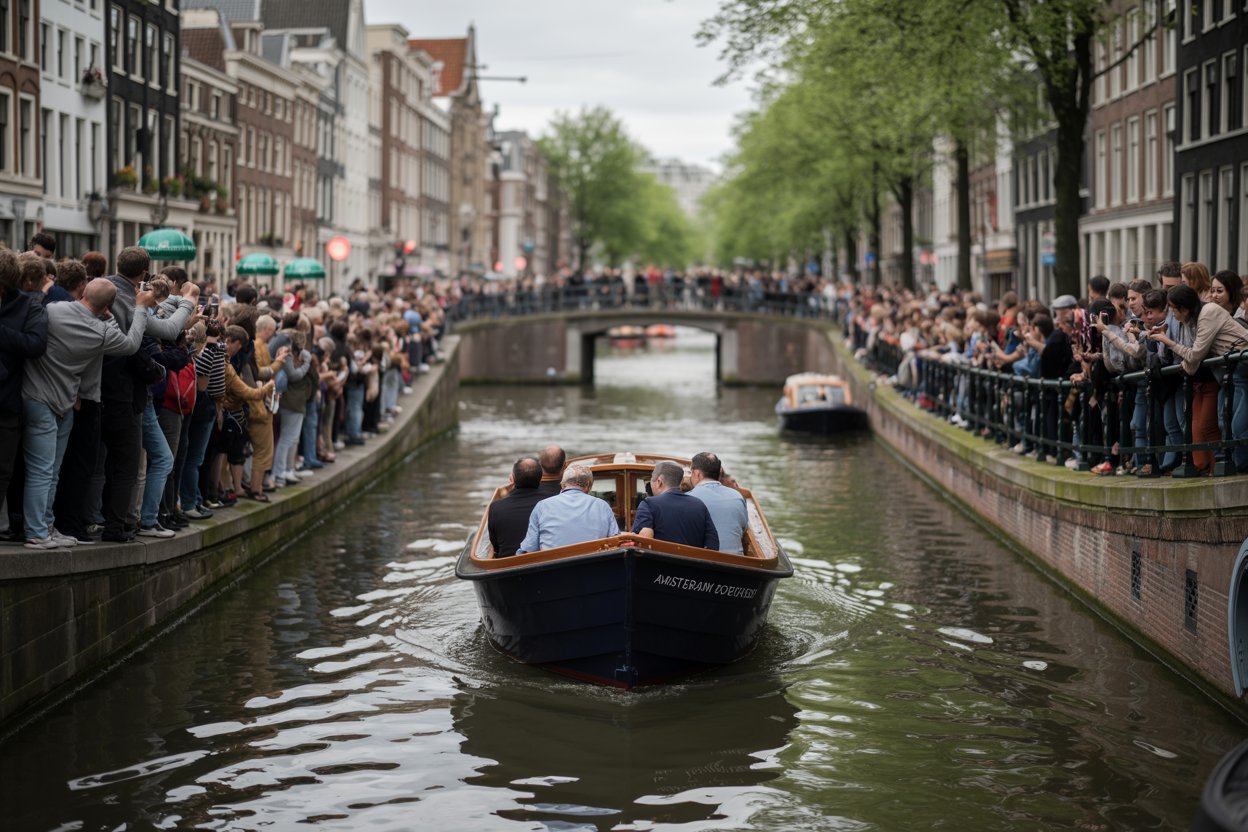≡-Netherlands Faces Growing Protests as Amsterdam Overtourism Threatens to Overwhelm Locals and Turn the City Into a Tourist Playground – Viral of Today
<> Viral of Today <>
Home » TOURISM NEWS » Netherlands Faces Growing Protests as Amsterdam Overtourism Threatens to Overwhelm Locals and Turn the City Into a Tourist Playground Published on
August 29, 2025Amsterdam has been grappling with the growing issue of Amsterdam overtourism, which has sparked widespread discontent among locals. As the number of visitors continues to soar, residents are voicing concerns that their city is becoming “unliveable.” The overwhelming tourist influx has led to overcrowded streets, rising housing costs, and significant pressure on local infrastructure. This has resulted in protests and campaigns aimed at addressing the issue of Amsterdam overtourism and its impact on daily life.The Protest Against Amsterdam OvertourismThis past weekend, a large number of Amsterdam residents gathered in front of the newly built Diamond Hotel, located in the Leidseplein area. The hotel, which replaced the iconic Heineken Hoek, has become a symbol of the tourism boom that many feel has gone too far. The building’s controversial design has led to criticism from locals, who have labeled it an eyesore and compared it to a motorway rest stop. For many, the Diamond Hotel represents the growing problem of Amsterdam overtourism, with fears that it will attract even more tourists and contribute to the already overcrowded city.Dingeman Coumou, a prominent figure in the “Het is Genoeg” (“That’s Enough”) movement, shared his frustration with the new hotel. According to Coumou, the hotel is just another example of the type of development that prioritizes tourism over the needs of locals. He called the Diamond Hotel a symbol of how Amsterdam overtourism is slowly suffocating the city’s authentic character and disrupting the everyday lives of its residents.The Impact of Amsterdam Overtourism on Local LifeWhile Amsterdam is known for its scenic canals, rich culture, and historic landmarks, the city’s appeal has led to rising concerns about Amsterdam overtourism. In 2023, the city saw over 22 million overnight visitors, far exceeding the target of 20 million tourists that local authorities had set for the year. This overwhelming number of visitors has made it increasingly difficult for residents to enjoy their city, with rising property prices, overcrowded streets, and a lack of space becoming persistent issues.Local resentment is growing, with many feeling that the influx of tourists is contributing to skyrocketing real estate prices, pushing out locals in favor of tourists and investors. The challenge of balancing the needs of residents with the demands of tourism has become more pressing, as families and longtime locals struggle to afford housing in their own city. Some argue that Amsterdam is no longer a place for its residents, but rather a destination for travelers.Overcrowding: The increasing number of tourists has led to congested streets and public spaces.Rising Housing Costs: Property prices are soaring as demand from tourists and short-term rentals increases.Pressure on Infrastructure: Local services are overwhelmed, affecting the quality of life for residents.Amsterdam’s Iconic Areas Strained by OvercrowdingAmsterdam’s historic old town and the famous red-light district, home to legal brothels and cannabis cafés, have become particularly strained by the pressure of Amsterdam overtourism. These areas attract large numbers of tourists, particularly younger visitors who come to experience the city’s vibrant nightlife. However, their behavior, which often includes excessive drinking and drug use, has led to frustration among residents who find the atmosphere disruptive.Ed Huijg, a local protestor who lives in the Wallen red-light district, shared his experience of navigating the crowds. “You have to fight your way through the masses to get home,” he said. Huijg’s frustration echoes the growing resentment among residents who feel their neighborhoods are being overtaken by tourists.Tourist Behavior: Public intoxication and loud behavior are increasingly common in popular districts.Impact on Local Community: Neighborhoods that were once quiet and residential are now dominated by tourism.Noise and Disruption: Local residents face daily disturbances from the constant influx of visitors.City’s Response: Amsterdam Tourism Restrictions and MeasuresTo address the growing concerns about Amsterdam overtourism, city officials have introduced a series of measures aimed at curbing the impact of tourism. These measures include Amsterdam tourism restrictions, such as the imposition of tourist taxes, the introduction of a “Stay Away” campaign, and a new “Amsterdam Rules” quiz for tourists. These steps are part of the city’s strategy to control the flow of visitors and reduce disruptive behaviors.Despite these measures, the tourist influx continues to rise, making it clear that more needs to be done to tackle the issue. In addition to the increased tourist taxes, Amsterdam has also limited the number of river cruises operating in the city and placed a temporary ban on new hotel developments. However, many residents feel these measures are insufficient in the face of the ongoing rise in tourism.Tourist Taxes: Increased taxes are designed to discourage short-term visitors and raise funds to support the city’s infrastructure.Stay Away Campaign: Aimed at promoting responsible tourism and discouraging disruptive behavior.Amsterdam Rules Quiz: An initiative to educate tourists about local norms and reduce antisocial actions.A Growing Trend: Local Resentment and ProtestsThe situation in Amsterdam is not unique. Other European cities, including Barcelona and Venice, have seen similar protests from residents who feel that overtourism has negatively impacted their communities. Local resentment is growing in these cities as well, with residents voicing concerns over the rising costs of living and the loss of their cities’ authentic character. In response, some European cities are shifting their focus away from attracting mass tourism, aiming to draw fewer but more high-spending visitors who stay longer and have a less disruptive impact.As for Amsterdam, the protests and demonstrations show that locals are becoming increasingly vocal in their opposition to Amsterdam overtourism. The city will likely continue to implement measures to control tourism, but the challenge remains: how to find a balance between welcoming visitors and maintaining a livable environment for residents.Global Issue: Other cities like Barcelona and Venice are facing similar challenges with overtourism.Sustainable Tourism: The shift toward attracting high-value, long-stay tourists is gaining momentum across Europe.Conclusion: Tackling Amsterdam OvertourismIn conclusion, Amsterdam overtourism has become a pressing issue for residents who feel that the city is being overwhelmed by tourists. The Amsterdam protest, coupled with measures like tourist taxes, Amsterdam tourism restrictions, and campaigns to curb disruptive behavior, show that city officials are trying to manage the influx of visitors.However, despite these efforts, the growing number of tourists continues to strain local resources, raise housing costs, and disrupt the daily lives of Amsterdam residents. As the debate continues, finding a sustainable solution to Amsterdam overtourism will be key to ensuring that the city remains both a vibrant tourist destination and a livable place for its inhabitants.
This information will surprise you!
See also
- Read until the end to discover everything.
- Important information you need to know.
- Interesting facts and helpful tips.
Conclusion
Did you enjoy the news? Keep following us daily!













